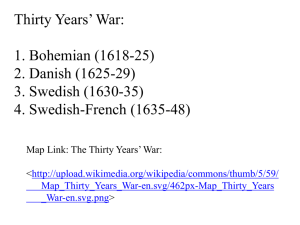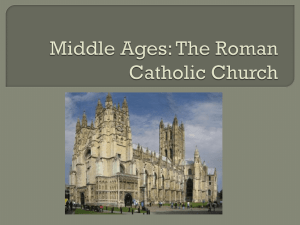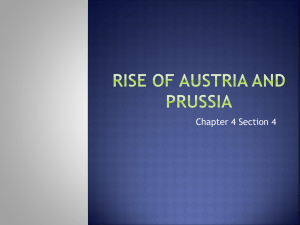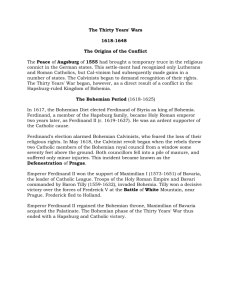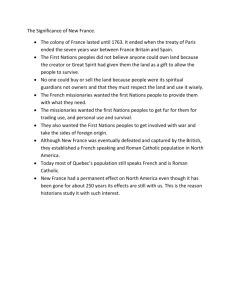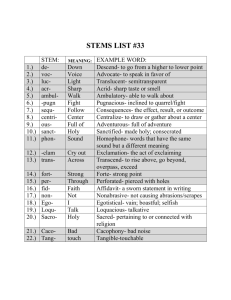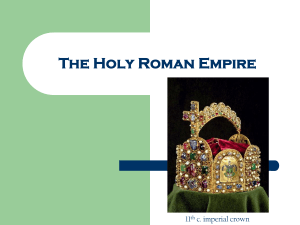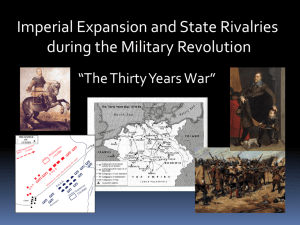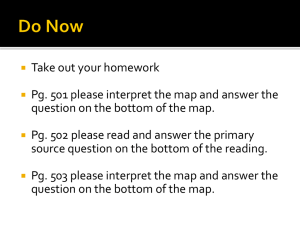Thirty Years` War
advertisement
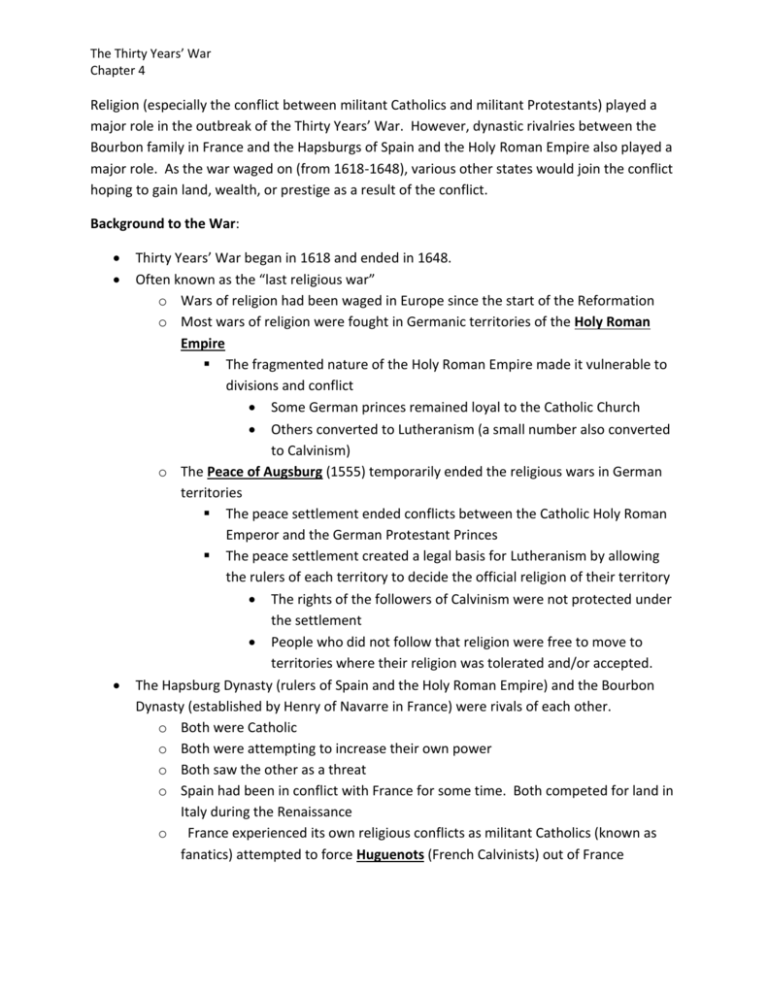
The Thirty Years’ War Chapter 4 Religion (especially the conflict between militant Catholics and militant Protestants) played a major role in the outbreak of the Thirty Years’ War. However, dynastic rivalries between the Bourbon family in France and the Hapsburgs of Spain and the Holy Roman Empire also played a major role. As the war waged on (from 1618-1648), various other states would join the conflict hoping to gain land, wealth, or prestige as a result of the conflict. Background to the War: Thirty Years’ War began in 1618 and ended in 1648. Often known as the “last religious war” o Wars of religion had been waged in Europe since the start of the Reformation o Most wars of religion were fought in Germanic territories of the Holy Roman Empire The fragmented nature of the Holy Roman Empire made it vulnerable to divisions and conflict Some German princes remained loyal to the Catholic Church Others converted to Lutheranism (a small number also converted to Calvinism) o The Peace of Augsburg (1555) temporarily ended the religious wars in German territories The peace settlement ended conflicts between the Catholic Holy Roman Emperor and the German Protestant Princes The peace settlement created a legal basis for Lutheranism by allowing the rulers of each territory to decide the official religion of their territory The rights of the followers of Calvinism were not protected under the settlement People who did not follow that religion were free to move to territories where their religion was tolerated and/or accepted. The Hapsburg Dynasty (rulers of Spain and the Holy Roman Empire) and the Bourbon Dynasty (established by Henry of Navarre in France) were rivals of each other. o Both were Catholic o Both were attempting to increase their own power o Both saw the other as a threat o Spain had been in conflict with France for some time. Both competed for land in Italy during the Renaissance o France experienced its own religious conflicts as militant Catholics (known as fanatics) attempted to force Huguenots (French Calvinists) out of France The Thirty Years’ War Chapter 4 Violence between Calvinists and Catholics left thousands dead (St. Bartholomew’s Day Massacre) The War of the Three Henrys was fought in part due to religion and caused a civil war The French wars of religion ended with the Edict of Nantes passed by Henry of Navarre in 1598 Since the Peace of Augsburg did not protect Calvinism as a religion in German territories, Frederick the Elector of Palatinate created the Protestant Union as a means of protecting the rights of Protestant rulers in the HRE o Catholics led by Maximilian of Bavaria countered by creating the Catholic League of German States. o As a result, German states were again on the edge of religious war Power struggles between the Holy Roman Emperor (who was Catholic) and the German Princes (many of which who were Protestant) caused further tension. o The Holy Roman Emperor turned to Spain (who was also ruled by Hapsburgs) for help o The German Princes turned to France and other states for help Both France and Spain were Catholic, but France was willing to help the Protestant princes because the Bourbon family in France saw this war as an opportunity to destroy the power of the Hapsburg family who they had been rivals with for a long time. Historians have traditionally divided the Thirty Years’ War into 4 stages o o o o The Bohemian Phase (1618-1625) The Danish Phase (1625-1629) The Swedish Phase (1630-1635) The French Phase (1635-1648) The Bohemian Phase of the war o In 1617, Archduke Ferdinand II of the Hapsburg family was appointed ruler of Bohemia (a German territory) o He was a devout Catholic and began a campaign to enforce Catholicism on the people of Bohemia. Ferdinand II would soon after be elected as Emperor of the Holy Roman Empire o The Protestants of Bohemia rebelled against this o In 1618, Protestants stormed the government building in Prague and threw two of the Hapsburg governors out the window (known as the Defenestration of Prague). The Thirty Years’ War Chapter 4 o Rebels then seized control of Bohemia and went into full rebellion against the Holy Roman Empire o Protestants then invited Frederick the Elector of Palatinate to be the ruler of Bohemia, he accepted o Ferdinand (who was now the Holy Roman Emperor) refused to accept this. He enlisted the help of the Catholic League and Maximilian of Bavaria. o The Bohemian Phase of the war resulted in Catholic victories. Frederick fled into exile. o The Spanish used this war as an opportunity to attempt to suppress an uprising in their Dutch territories The Netherlands had been part of the Spanish empire, but they began to rebel The Danish Phase of the War o King Christian of Denmark, a Lutheran, intervened to help the Protestants. He also hoped to gain lands in Northern Germany after the war was over. He made an antiHapsburg alliance with England. o Albrecht von Wallenstein was appointed commander of the Catholic army o He was a brilliant military man and also a master manipulator who used the war to increase his own wealth. Wallenstein was also a controversial figure since his loyalty was often in question. o Again, the Catholics assumed victory o Emperor Ferdinand II passed an edict to prohibit the practice of Calvinism This act made some of the German princes nervous. They feared that Wallenstein would be too successful and become a threat to their own power. The princes convinced Ferdinand II to remove Wallenstein from his command. The Swedish Phase of the War o Gustavus Adolphus (king of Sweden, Lutheran, known as the “Lion of the North”) entered the war o Sweden had become a military power under the king’s leadership o The Swedish army had great initial success and turned the tide of war in favor of the Protestants. Emperor Ferdinand II was forced to recall Wallenstein to lead the Catholic forces o Gustavus Adolphus was killed in one of the battles o In 1634, Emperor Ferdinand ordered the assassination of Wallenstein The Thirty Years’ War Chapter 4 The French Phase of the War o Cardinal Richelieu (advisor to the king of France) convinced King Louis XIII to join the war to aid the Protestant princes o The French saw this war as an opportunity to increase France’s power by weakening the Hapsburgs o The French were able to defeat the Spanish army o France assumed a role as the dominant power in Europe o The war came to an end with the Treaty of Westphalia (1648) The Treaty of Westphalia o Signed in 1648 to end the Thirty Years’ War o Gave all German territories the right to choose their own religion o France gained territories along the border between France and Germany (Alsace, Verdun, Metz, Toul) o Sweden gained lands in Germany o Brandenburg and Bavaria also gained more land o The territories of the Holy Roman Empire were recognized as largely autonomous states and were given the power to negotiate their own foreign policy without interference of the Holy Roman Emperor o The Holy Roman Emperor lost power and became only a figurehead of the HRE o Established a precedent of “separation of church and state” Impact of the War o The war was fought largely in German territories, some of which were devastated by the war o The Holy Roman Empire suffered a population decline o Over 4 million dead during the conflict o Some towns saw a ¾ loss of population while others suffered about 15-20% loss in population o Europe’s population increased in the 16th century and then decreased in the 17th century due to religious wars
